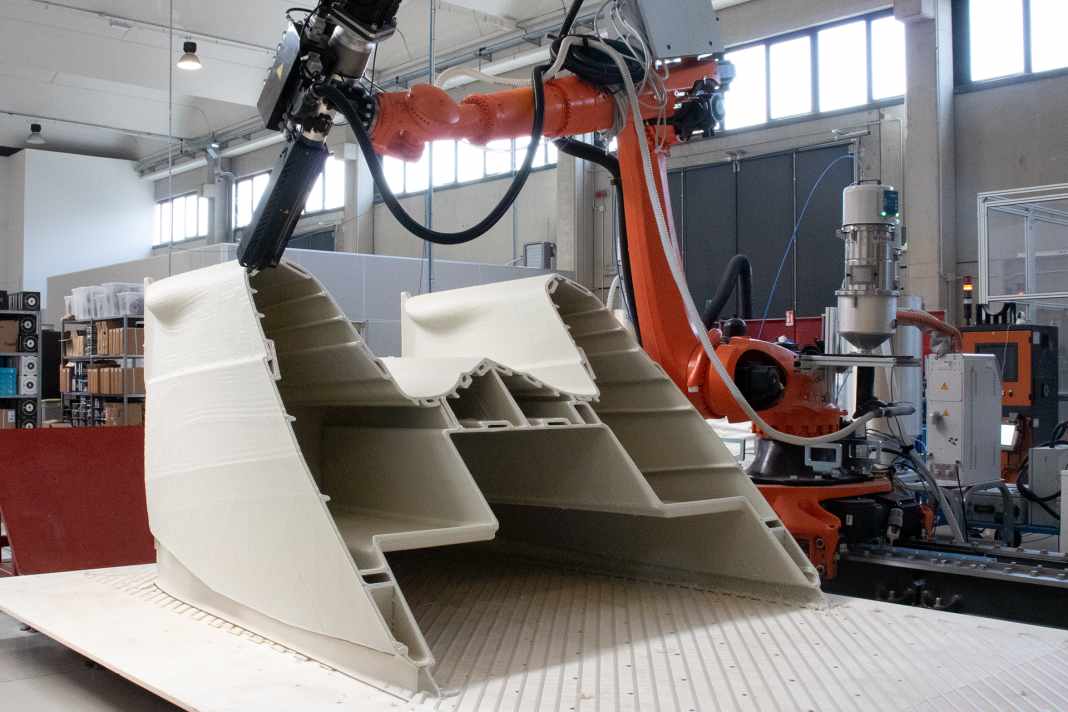





One layer at a time. The implementation of 3D printing in yacht construction is similar to the process of creating a component using additive manufacturing. While initially it was true-to-scale models or component samples as part of the development process (rapid prototyping), from 2019 boats under ten metres in length were created using additive processes throughout.
Moi Composites boasted the world's first 3D-printed fibreglass boat at the end of 2020 and emerged from a spin-off of the Milan Polytechnic. The almost-catamaran "Mambo" (Motor Additive Manufacturing Boat) is 6.50 metres long, extremely free-form and has two hulls at the front but a closed stern. Many small sections were produced by two algorithm-controlled industrial robots, which were laminated to form a continuous hull structure weighing 800 kilograms. The mechanical properties of the composite are said to be comparable to those of unidirectional fibreglass.
The first boat from the 3D printer
Even earlier, "3Dirigo" from the polytechnicians at the University of Maine (UMaine) caused a sensation. Back in 2019, the engineers from the US East Coast succeeded in producing a centre console measuring 7.80 metres across using a 3D polymer printer and partly bio-based raw materials such as cellulose filaments. The record-breaking hull still had to be milled from the printed frame and had one major disadvantage: ready to go, the grooved boat weighed in at 2,260 kilograms. A conventionally laminated and fully equipped sports boat of the same length displaces slightly less than half this weight.
Industrial robots for large moulds
V2 Boats presented a printed premiere on two hulls at the beginning of 2025, when a robot from Caracol materialised a six-metre-long catamaran for the Spanish company. The company from the north of Milan has been using large-format additive manufacturing, which is based on 3D printing and in which workpieces are created based on a digital model by adding material layer by layer, since 2015. The actual application of fibre-reinforced thermoplastic granulate is carried out by a heated nozzle with a diameter of eight millimetres.
The spray module is moved by a six-axis robot from Kuka, which follows pre-programmed paths along a twelve-metre-long track. The monolithic structure of the catamaran took the jet robot unit 160 hours to complete. The net weight of the 500 x 230 x 150 cm hull is 1,200 kilograms. According to Caracol, it is the most suitable production method for highly customisable designs - with efficient use of materials and a significant reduction in environmental impact. Mould construction is eliminated, there is said to be 30 percent less waste products and the hull is 90 percent recyclable.
Finish: With or without grooves?
Caracol explains that the design and slicing phase required additional time due to the considerable size of the boat and the complicated geometries. However, many of these preparatory steps - such as fine-tuning the process parameters, optimising the structural balance with printability and planning post-processing - are a one-off effort per boat model. Once the optimisations have been completed, the parameters can be transferred to several prints, which should significantly reduce the preparation time for subsequent prints and streamline the production process. After printing, the final processing by CNC milling machine is followed by gelcoat coating and painting.
Start-ups in other countries such as Sweden and the Netherlands rely on similar technology. Tanaruz is even planning a cabin cruiser there, which is being built by a 3D printer from the Swiss-Swedish electronics group ABB. Impacd Boats relies on collaboration with TU-Delft for its sloops, whose 3D-printed origin can be recognised by the raw finish with grooves. The Dutch company feeds its "boat-building machine" with filament made from recycled PET bottles.
Superyacht components from the 3D printer
It will probably be some time before superyachts come out of the printer in their entirety. However, the Ferretti Group additively manufactures multi-convoluted ventilation grilles for the Pershing GTX116. With the help of Caracol's equipment, the Italian shipyard group claims to have reduced the throughput time for this part by 50 per cent, waste by 60 per cent and weight by 15 per cent.
The Ferretti Group operates large-format 3D printers from the Italian manufacturer Wasp in its own halls. These are compact, closed housings, as we know them from smaller devices. The nozzles of the Power 45 HDP are fed with granulate made from glass fibre-reinforced and partially recycled plastic and work in an interior measuring 110 x 200 x 50 centimetres. Hatches, hinged drawers, dashboards and seat brackets for Ferretti Yachts have already been made from this material.

